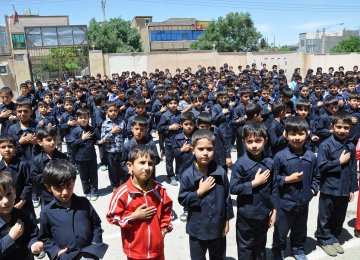More than 52,000 new classrooms need to be added to the existing number to meet demand for enrolment of students at all school levels and promote equitable access to education, said Mohammad Taqi Nazarpour, deputy minister of education and head of the Organization for Development, Renovation and Equipping Schools of Iran.
As per available data, there are over 560,000 classrooms in the country at present.
During a recent visit to Shahrekord, the capital of the southwestern Chaharmahal-Bakhtiari Province, he said 25,000 classrooms should be established in places where the Mehr Housing Scheme was implemented, “since basic facilities such as schools and medical facilities are essential in the vicinity of the housing units,” IRNA reported.
Earlier, Seyed Mohammad Pejman, deputy minister of roads and urban development had said that providing homes under the so-called Mehr low-cost housing project without the provision of basic facilities such as schools, transportation and health centers is irrational. “The incumbent government is making every effort to provide such facilities and services for the residents” in the typically working-class districts.
The controversial housing project launched in 2007 during former president Mahmoud Ahmadinejad’s tenure, is plagued with poor urban infrastructure and in some cases lacks basic utilities and services. Billions of dollars were pumped into the housing units across the country and as of January 2011, the banking sector, particularly Bank Maskan (the main housing lender), had doled out loans totaling more than $10 billion to applicants.
The aim was to construct 2 million low-cost houses for low-income families in five years. But the Mehr projects lacked the necessary amenities. Since the housing units were mostly located on city outskirts, construction of schools, health facilities, roads and public transport was imperative.
In January 2017, the Majlis voted to end the project after completion of the remaining phases and providing the basic amenities. According to published reports, many applicants who have already paid for the new houses refuse to take delivery because of inferior quality of the buildings, faulty construction and absence of basic needs. The government apparently is stuck with large numbers of the Mehr units as there are no buyers.
Contributions
Stating that more than 20-30% of educational spaces are built with financial assistance from philanthropists, Nazarpour said “last year (ended March 20), philanthropists gave $90 million (3,600 billion rials) to the organization which was spent on construction of schools in deprived areas, in particular Chaharmahal-Bakhtiari Province.”
Under a new plan developed by the ministry, half the budget for construction of each school is provided by the government and the remaining by philanthropists and charities. Once completed, the school will be named after the donor.
In the past 11 years (2005-2016), philanthropists have contributed $700 million (28,000 billion rials) for constructing schools in different parts of the country.
On the number of classrooms built during the present government’s tenure which ends in mid-summer, the official said 36,000 classrooms were established on five million square meters of land and 12,000 classrooms (30%) were constructed by patrons.
Pointing to the short life span of existing schools (20 years), Nazarpour stressed that the quality of the constructions should be improve. “In future, new school buildings will be built with reinforced materials so as to extend their life span.” This would remove the need for frequent renovation and retrofitting.
Earlier this year, he had said under a school renovation project, 4,230 existing structures were being renovated and retrofitted to augment educational spaces and provide safe school environments. The projects cover 17,143 classrooms (around 3% of all classrooms in the country).
Safer Schools
Nazarpour said since five years, substandard gas heaters have been replaced with central heating systems in 130,000 classrooms. An unsafe heater can cause a fire or pollute the premises with noxious fumes. However, around 80,000 classrooms are still using unsafe oil heaters.
According to figures released in 2013, out of the 530,000 classrooms then, around 211,000 (nearly 40%) did not have safe heating systems. Between 2013 and 2015, nearly $194.4 million was allocated to replace outdated heating systems with modern ones in 107,000 classrooms. From February 1998 to 2012, there were at least seven school fires due to faulty heating systems killing four students and severely injuring 63.
There are more than 14 million students in Iran. About five million are studying at the primary, five million in middle and two million at the high school levels.
According to the UNICEF, free, equitable, quality education can increase a country’s domestic product per capita by 23% in 40 years. Access to quality education is not a privilege; it is a basic human right.






Add new comment
Read our comment policy before posting your viewpoints